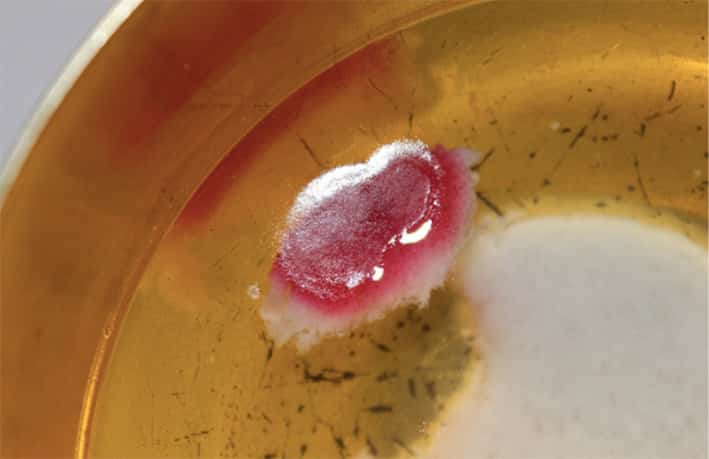
“Dear Father, I understand there has been another Eucharistic miracle in Poland, apart from the one you wrote about in Sokołka. Is this true and has the Vatican given any judgment on it?
On Christmas Day, 2013, in St Hyacinth’s church in Legnica, a city of 100,000 in southwest Poland, a priest accidentally dropped a consecrated Communion host on the floor. Following the normal procedure, he picked up the host and placed it in a bowl of water until it would dissolve. After two weeks, the host had dissolved only partially, and a red substance had appeared on it.
The Bishop of Legnica at the time, Stefan Cichy, then formed a commission to study the matter. In February of the following year a tiny fragment of the host was removed and placed on a corporal to be studied by the Department of Forensic Medicine of the Universities of Szczecin and Wrocław. The researchers found human DNA as well as tissue from the heart, which had alterations that often appear when a person is in a state of agony before dying.
When a Polish daily newspaper challenged the findings on the grounds that a certain bacteria thrives on bread and can create large amounts of a red substance similar to blood, the diocese responded that the Bishop had specifically asked the researchers in Wrocław and Szczecin to check whether the red substance was of bacterial or fungal origin, and they had found no such evidence.
In January 2016, Bishop Cichy’s successor Zbigniew Kiernikowski referred the matter to the Vatican’s Congregation for the Doctrine of the Faith. On 10 April of that year, following the Holy See’s recommendations, he asked the parish priest, Fr Andrzej Ziombrze, to prepare a suitable place for the relic so that the faithful could give it due adoration. He also asked for instruction to be given to the faithful so that they would have the proper attitude to devotion to the Eucharist, and for a book to be prepared where favours and other supernatural events could be recorded.

Bishop Kiernikowski said that he hoped this would serve to deepen the cult of the Eucharist and have a deep impact on the lives of people viewing the relic. “We interpret this amazing sign as an expression of the generosity and love of God, who stoops so low to be with man”, he said.
On 2 July, the host was placed in a reliquary for public view in St Hyacinth’s. More than 3,000 faithful attended a liturgy of expiation in the Legnica cathedral and subsequent procession to St Hyacinth’s Shrine, where the reliquary was placed on the church’s main altar during a Mass celebrated by Bishop Kiernikowski.
Bishop Kiernikowski said he hoped that the miraculous host would strengthen Eucharistic devotion among his people. Legnica is one of Poland’s least-religious dioceses, where weekly Mass attendance stands at just 29.9 per cent, compared to the national average of 39.1 per cent.
Fr Ziombra said there have already been miraculous conversions and healings, and there is a large number of pilgrims from all over the world travelling to Legnica to pray before the miraculous host. All of this documentation will be presented to the Holy See to assist in its evaluation of the extraordinary event.
We interpret this amazing sign as an expression of the generosity and love of God, who stoops so low to be with man. Bishop Zbigniew Kiernikowski
Among the conversions was that of a man from Legnica who had been hostile to the Church all his life and even fought against it. In an extraordinary way he was converted in a way not even he could understand. He made his first confession and received Holy Communion for the first time in fifty years. There have been other conversions as well.
Interestingly, St Hyacinth, the first Polish Dominican and a companion of St Dominic, had his own involvement with the Eucharist. In 1240, during the Siege of Kiev by the Mongols, as the friars were fleeing, Hyacinth went to rescue the ciborium with the Blessed Eucharist from the tabernacle in the monastery chapel. He heard the voice of Mary, asking him to take her with him. Hyacinth lifted the large stone statue of Mary and saved both the Blessed Sacrament and the image of Our Lady.
Related:
